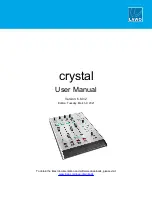
18
Remove the pin securing the jack stand in the stow position;
then turn the jack stand upright and install the pin. Using the
jack stand, lift the hitch of the Turf Tender until it is no longer
putting weight on the tractor drawbar.
Chock the Turf Tender wheels to prevent movement; then
remove the pin from the hitch.
Make sure there is no further connection between the tractor
and the Turf Tender. Get on the tractor, start the engine, release
the parking brake and drive away.
WARNING
The Turf Tender must be hooked up to the tractor
prior to loading. Failure to do so may result in
damage, injury or even death.
HOPPER CONVEYOR BELT SYSTEM
Overview
The conveyor running along the bottom of the hopper on
the Turf Tender is used to unload the hopper. It is generally
run backward to unload material from the back of the hopper.
On models with a front door, the conveyor may be reversed to
run material out the front. The conveyor controls are located
on the control box, which should be mounted on the towing
vehicle.
Two types of belts are used (depending upon model) for
the hopper conveyor. Spliced and endless belts are the two
types of belts used. Each conveyor belt has a center V-belt
vulcanized on the inner side to help keep the belt centered on
the rollers. Instructions for tightening of the belt and belt
replacement follows later in the Maintenance section.
On larger models (414, 420, and 440), the conveyor has
drive motors on each end. The dual drive motor design gives
additional power in each direction and also helps limit the
chances of belt slipping off track.
On the 420 and 440 models, a diamond wiper system is
located between the belts in the center of the hopper. This
wiper is used to help eliminate a buildup of materials on the
inner side of the belt. A material buildup could cause the belt
to run off track or jam. The diamond wiper generally prevents
these problems.
Turf Tender models are equipped with either an electric or
manual control to adjust the speed of the conveyor belt. On all
models (except the self-contained models, the
master switch
must be turned on first to allow the other controls to
function.
The red light on the control box will be illuminated
when the master switch has energized the rest of the control
box functions.
NOTE: To prevent battery discharge, remember to
turn the master switch and the towing vehicle’s
ignition switch to the OFF position when not using
the Turf Tender.
On models with only a rear gate, the conveyor switch is a
two position switch (ON and OFF). On models with front and
rear gates, the conveyor switch is a three position switch
(REARWARD-OFF-FORWARD). Moving the switch from the
OFF position, will engage the belt in the direction as indicated
on the switch decal. To unload the hopper, be sure to open the
appropriate gate before running the conveyor. The gate(s) may
be left open a limited amount if the material being hauled does
not leak out when the conveyor is not running.
NOTE: Before starting the main conveyor belt when
unloading from the rear, always first activate the
spinners. Failure to due so will result in material
piling up on the spinners.
The speed of the spinners may be adjusted to control the
spread width of the Turf Tender. There are two methods to
adjust hydraulic flow to the Turf Tender. Increasing the speed
of the conveyor increases the amount of material being
unloading. Use the appropriate section below to adjust conveyor
belt speed.
NOTE: Conveyor belt speed may also be adjusted
by changing the throttle speed on the vehicle (or
engine) supplying the hydraulic power. Speeding
up the engine will speed up hydraulic flow to the
machine. This will speed up the operation of all
features of the Turf Tender.
ELECTRIC-CONTROL MODELS
The master switch on the control box activates the hydraulic
valve. Once the master switch is in the ON position, the switch
marked “conveyor” will turn the conveyor ON and OFF. The
conveyor speed dial controls the belt speed (flow rate) of
material. Faster belt speeds result in higher application rates.
The numbers on the dial’s scale do not represent any particular
units, they are simply reference numbers to allow you to set
the speed the same each time. The relationship between flow
rate and dial scale are fairly linear; therefore, if the dial was
initially set at 40, raising the setting to 80 would roughly double
the material application rate.
OPERATION
















































